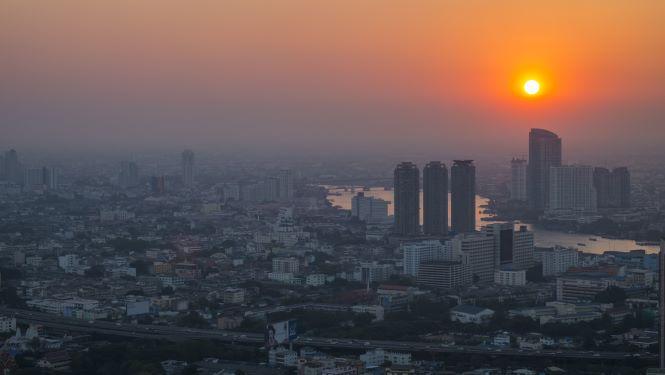

Bangkok Skyline is hazy due to smog
Bangkok, Thailand
On Wednesday, Toxic smog forced hundreds of Bangkok schools to shut down right upto Feb 4 possibly, as city authorities decided that pollution levels were too risky for life as usual.
The Thai capital has been shrouded in murky haze for weeks, sparking social media criticism of the uneven response by the government and prompting a huge increase in the number of residents donning masks on streets and on public transport. The PM 2.5 was recorded at 185. Yes, 185. Just for the record, Delhi’s average PM 2.5 for all of January was over 250, with possibly just three days when we hit Bangkok levels of pollution.
Reasons given for the Bangkok levels include exhaust from traffic, unfettered construction, the burning of crop stubble, and pollution from factories getting trapped in the city. Pretty much what we blame in Delhi too.
[related_post]
Authorities in Bangkok seeded clouds to get rain, sprayed overpasses with water to catch micro-pollutants. Additionally, officials fear conditions will be exacerbated by next week’s Lunar New Year celebration which will include widespread use of fireworks and incense. They are urging the people not to burn incense sticks and paper during Chinese New Year celebrations. Remember the Diwali requests, anyone?
Predictably, Bangkok residents are not impressed with the efforts. With stunts like drones to disperse sugary liquid solution to help clear the air of microscopic particles, they do understand that the measures are more spectacle than effective.
Three to four of the city’s districts are “severely hit with smog”, according to the Bangkok mayor. The Bangkok Metropolitan Administration stepped up its health warnings, ordering all 437 city-controlled public schools to close from lunchtime through Friday, designating 1,500 square kilometres (580 square miles) of the city a “control area”.
As Thailand faces future chronic air problems, Thai Prime Minister Prayuth Chan-Ocha, leader of Thailand’s military government, said he’s considering shuttering “some factories during pollution spikes to tackle the problem”. Air pollution is already hurting Thailand’s economy. The Kasikorn Research Center estimated that smog would cost the country up to 6.6 billion baht ($200 million), by raising healthcare costs by up to 3.1 billion baht and reducing tourist spending by up to 3.5 billion baht.
New Delhi, India
The overall air quality in the national capital slipped into the ‘very poor’ category on Thursday as expected. According to the System of Air Quality and Weather Forecasting And Research (SAFAR), the air quality index (AQI) was recorded at 319 on Thursday morning.
The overall PM2.5 (fine particulate matter in the air with a diameter of less than 2.5 micrometre) level in Delhi was recorded at 145 in the ‘very poor’ category while the PM10 (fine particulate matter in the air with a diameter of fewer than 10 micrometre) level was recorded at 251.
While schools in Delhi too were shut in the month of January 6-12 due to the similar conditions and severe cold. Post-Diwali the weather due to the polluted air in Delhi, many asthma patients, particularly those with Chronic Obstructive Pulmonary Disease (COPD), experience acute attacks and other problems that aggravate their condition. Even those with no prior history of such ailments begin experiencing breathing issues.
But Delhi’s polluted air is not just affecting your lungs and resulting in respiratory disorders, it might also be adversely affecting your brain, memory, IQ, learning and behaviour. Results of a study —‘Death in Every Breath’ — that were released recently by the NGO Lung Care Foundation revealed high levels of neurotoxins in Delhi’s air that can cause damage to the brain or the peripheral nervous system. Growing evidence suggests that inhalation of fine and ultrafine particles commonly found in air pollution can damage the brain and increase the risk of developing dementia and Alzheimer’s disease.
Samples of air taken from Delhi and Gurugram in November and December 2018 point towards an alarming presence of toxic heavy metals like manganese, nickel and lead, in addition to PM2.5. According to a study by World Bank the cost of serious health consequences from particulate pollution or PM2.5 air pollution is estimated at 3 percent of India’s GDP.
The Most Vulnerable
Another study related to children say that exposure to air pollution, particularly at school, could be associated with a higher risk of overweight and obesity during childhood. This is the conclusion of a study by the Barcelona Institute for Global Health (ISGlobal) that was released yesterday.
“We observed that children exposed to medium or high levels of air pollution at school -ultrafine particles, NO2, PM2.5 and EC- had a higher risk of obesity and overweight as compared to those exposed to lower levels,” concludes first author Jeroen de Bont, researcher at ISGlobal and IDIAP Jordi Gol. Studies suggest that pollution can induce oxidative stress, insulin resistance and systemic inflammation. The study, published in Environment International and performed under the BREATHE project, assessed air pollution levels at school and home, the two microenvironments where schoolchildren spend most of their time.
The World Health Organization says 4.2 million people die every year as a result of exposure to outdoor air pollution, and when combined with household air pollution deaths, the number spikes to 8 million. Additionally, 91 percent of the world’s population lives in places where air quality exceeds the agency’s guideline limits.
1. The mandate for blending Compressed Biogas (CBG) with natural gas has come into effect…
Andhra Pradesh is striving towards greening its energy sector with quite some speed. In a…
With an objective to bolster India’s green energy goals, a Tripartite Agreement has been signed…
The Union MNRE Minister Pralhad Joshi launched the Green Hydrogen Certification Scheme of India (GHCI)…
India’s energy conglomerate Bharat Petroleum Corporation Limited (BPCL) has commissioned a 5MW green hydrogen plant…
In a historical development, the European Space Agency (ESA) has successfully launched its pioneering ‘Biomass’…